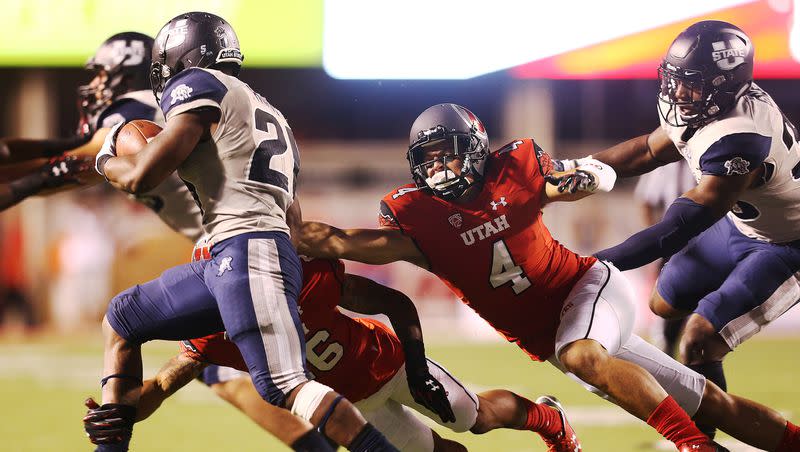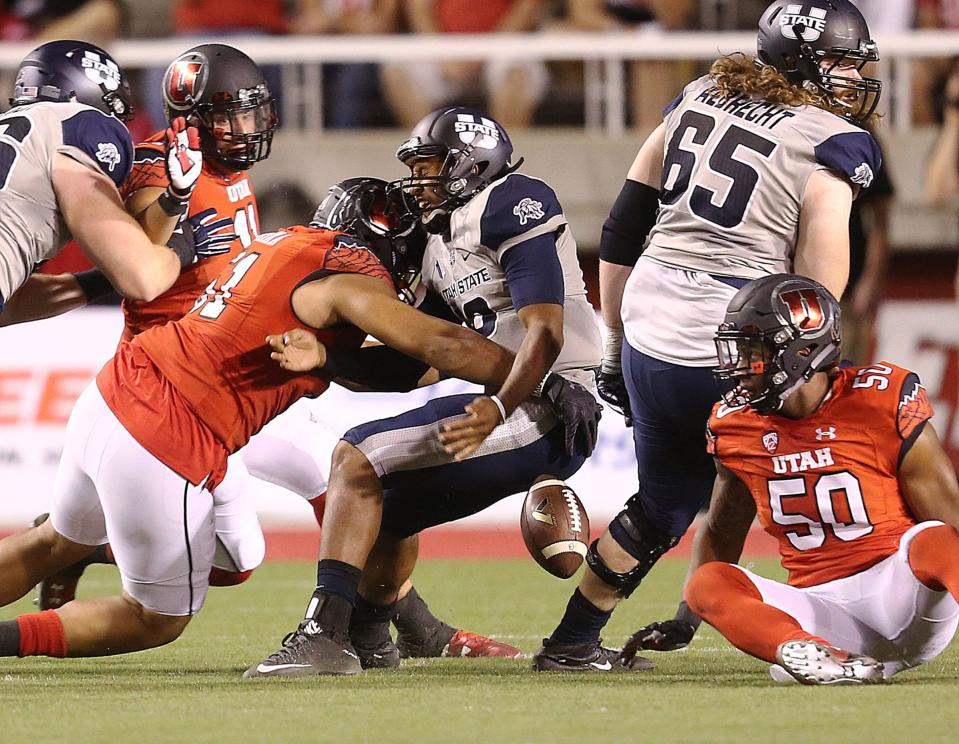The Utah State-Utah rivalry has been renewed. Is that a good thing for the Aggies?

- Oops!Something went wrong.Please try again later.
The Battle of the Brothers is back.
Utah and Utah State announced Thursday morning that the two football programs have renewed their in-state rivalry with three scheduled games: one in 2024, another in 2026 and the third to be played in 2031.
The first game will be played in Logan, the latter two in Salt Lake City.
It is the renewal of the most-played rivalry in Utah State football history.
Begun in 1892, the Aggies and Utes have played 112 times, with that number now set to rise by three.
By way of comparison, Utah State and BYU have played 91 times in the Battle for the Old Wagon Wheel, while USU and Colorado State have met 79 times.
Oh, and Utah State and Wyoming have played 72 times, with Bridger’s Rifle only recently joining the affair.
The renewal of Utah State’s longest-standing rivalry — recent hiatus notwithstanding — was greeted with much fanfare, particularly on the Aggies’ side of things.
Said USU athletic director Diana Sabau in a release: “It is tremendous for our football program to host the University of Utah this fall. Aggie Nation has certainly stressed the importance of in-state matchups in my short time at USU. Thank you to Utah Athletics Director Mark Harlan and his staff for making football in the state of Utah important for our fans.”
Related
Scott Garrard, voice of the Aggies, wrote on X, “This is good for the state and fun to see. Utah State is going to have three “PAC 12” opponents on their schedule next year. USC, Utah, and either Oregon State or Washington State.”
The positive reactions didn’t end there. Aggie fans were understandably thrilled with the renewal of the rivalry, especially since the first game of the series will be played in Maverik Stadium, the first trip north to Cache Valley by Utah since 2012.
There were calls for BYU to join the fray too, which would bring back the Battle for the Beehive Boot, the three-way rivalry between the Aggies, Cougars and Utes, but overwhelmingly there was excitement that Utah State and Utah will be playing football again. And soon.
How beneficial is the renewal of the Battle of the Brothers, though? Specifically for Utah State.
There are genuine pros and cons to the return of the series.
The 2-for-1 debate
The biggest con, at least on the surface, is that in order to play Utah again Utah State had to agree to a 2-for-1, meaning the Aggies will play at Rice-Eccles Stadium twice, while the Utes will only play at Maverik Stadium once.
That sort of lopsided series has been a point of contention for years between Group of Five and Power Five programs, and not just in Utah.
Across college football, Group of Five programs have battled for respect from in-state Power Five programs — respect shown via home-and-home series — sometimes to great effect, other times not.
Take Florida and UCF for instance.
The Gators and Knights have only played three times ever, despite only being separated by 120-plus miles and both programs competing at the FBS level since 1996.
The sticking point was the 2-for-1 series, which got considerable publicity during UCF’s highly successful run under Scott Frost. The Knights were the best Group of Five team in the country at one point, but the only series offered by the Gators was a 2-for-1, an offer UCF turned down.
Then UCF athletic director Danny White, now at Tennessee, said at the time, “I think we’re at the top level. I’m not going to waste any time trying to schedule for a four-team playoff, because it’s not a playoff, it’s an invitational. It’s not an adequate postseason. I think our schedule works great for an eight-team playoff; I think that’s where it needs to go.”
UCF and Florida are slated to play in 2024, but only after UCF caved and accepted a 2-for-1 offer.
Then there is Colorado and Colorado State. The Buffaloes and Rams have met 92 times in what is known as the Rocky Mountain Showdown, and through the late 1990s those meetings were fairly even, held regularly in both Fort Collins and Boulder.
The Rams and Buffaloes then decided to play yearly at a neutral site, in Denver, though that arrangement has now come to an end after 20-plus years.
The new agreement between the in-state rivals is once again a home-and-home series — through 2038 — even though Colorado is a Power Five school headed to the Big 12 and Colorado State is a Group of Five school in the Mountain West.
While Utah State was able to get BYU to agree to home-and-home series throughout the Cougars’ tenure as an independent, Utah and Utah State haven’t had a home-and-home series since 2012 and 2013, not so coincidentally two of the last three times the programs have met.
There will be benefit to Utah State playing Utah, even in a 2-for-1 scenario, but it isn’t the ideal scenario for the Aggies.
Recruiting, recruiting, recruiting
Perhaps the biggest positive for Utah State from the renewal of the Battle of the Brothers is on the recruiting front.
The Aggies consistently recruit head-to-head against Utah, BYU, and numerous other Power Five and Group of Five programs in Utah and are consistently beaten out for recruits.
And as USU coach Blake Anderson recently said, recruiting in Utah is more competitive now than it has ever been.
“We all know the numbers in the state of Utah. We can’t live by Utah kids alone,” Anderson said. “You’ve got some really good people coming in recruiting. We are struggling head-to-head with a lot of Pac-12 and Power Five programs.”
Related
Will that change dramatically just because the Utes and Aggies are playing again? Of course not, but competitive showings by Utah State against Utah can’t hurt the Aggies’ efforts to reel in some of the state’s best prospects.
Perhaps more importantly, showing the ability to play against and compete with a high-level Power Five program like Utah should only help the Aggies in recruiting battles outside of the state.
Recruiting in California, Texas and throughout the junior college ranks.
Under Anderson, the Aggies have made excellent use of juco prospects and currently have a good-to-great group of juco prospects committed for the class of 2024.
Give players a chance to compete against a Utah team that could, based on its recent success, be a regular College Football Playoff participant though, and the Aggies should be able to reel in even more talent.
Then there is the transfer portal.
With so much player movement now, and potentially more to come given a recent ruling by U.S. District Judge John Preston Bailey in West Virginia, the chance to play Utah will give Utes who don’t get a lot of playing time an up-close-and in-person look at Utah State.
USU has done well with Utah transfers over the years, with a few exceptions, and meetings between the Utes and Aggies could be something of an audition.
There is always the threat that Utah entices the best Aggie players to leave as well, but most transfers primarily transfer down levels, not up. Which would work in Utah State’s favor.
College Football Playoff inclusion
Starting next season the College Football Playoff will expand to 12 teams. One of those teams is guaranteed to be the conference champion of a Group of Five league.
That berth will go to the highest ranked Group of Five champion, which makes the timing of the renewal of the series against Utah a difficult one for Utah State.
Could the Aggies lose to the Utes next season, still win the Mountain West Conference and be the highest ranked Group of Five champion next season? It’s possible.
And an upset of the Utes would go a long way in establishing USU in the national consciousness; however, with a schedule that includes a trip to USC, plus a game at Washington State — announced by the MW Thursday afternoon — and then the normal conference slate, USU’s 2024 schedule is looking like one of its most difficult in years.
Utah State, as of mid-December, appears to be surging toward the top of the MW, based on returners, transfers in and out, and the Aggies’ 2024 recruiting class.
All season long Anderson called the 2023 season, “Year One,” after Utah State had to replace 30-plus players who left via the transfer portal last offseason.
Year Two, on paper, looks like it could be a bounce-back season and much-improved campaign for the Aggies, after back-to-back middling 6-6 seasons.
Three losses to Power Five opponents would eliminate Utah State from CFP inclusion, even with a MW championship, though. Playing three Power Five-caliber teams will surely tax the Aggies, potentially limiting what USU can do in Mountain West play.
As the CFP committee just showed by selecting Liberty over SMU for this year’s Fiesta Bowl, wins and losses do matter (sometimes), regardless of the caliber of competition.
Were Utah State to have an incredible season of upsets, having Utah on the schedule would all but ensure a berth in the CFP. But beating the Utes, plus the Trojans and the Cougars realistically is too significant of a challenge for Utah State to make a run at the CFP next season.
Good ol’ bragging rights
The return of the Utah-Utah State rivalry does have the potential to provide Aggie fans with a renewed dose of something that has sustained many of them throughout the series hiatus — bragging rights.
The last time the Utes played in Logan the Aggies pulled off the upset and USU fans haven’t let Utah fans forget it since, even as the Utes have gone on to bigger and better things.
Another upset of Utah in Logan would do wonders for an Aggie fanbase that is perceived as the “little brother” by both Utah and BYU.
Plus, college football is at its best when tradition and history are involved, something that increasingly is becoming less and less a part of the sport thanks to conference realignment.
A return of the Battle of the Brothers is the return of the oldest and most played rivalry game in the state of Utah. It is a return to college football’s past. It is a return to geographical rivalries, games between brothers, cousins, neighbors and friends.
That means better attendance, more eyes — at least in Utah — and maybe a few more donations to NIL collectives. And potentially the creation of some of those long-lasting memories that make for lifelong fans of college football.
When the BYU-Utah State series ended, as part of the Cougars’ move to the Big 12, Anderson said, “It’s a great rivalry. I understand what is going on. I think we all saw this potentially coming with their move to the Big 12. Rivalry football is what college football is all about. I absolutely love it. I have not always been able to be a part of it but some of my most enjoyable experiences have been in these types of games. I hate to see it go.”
Is the renewal of the Battle of the Brothers a good thing for Utah State?
In some ways yes, in other ways no. It is back, though, beginning on Sept. 14, 2024.


